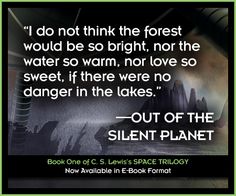I found Out of the Silent Planet by C. S. Lewis to be an intriguing mix of Greco Roman mythology, Christianity, and science fiction. The pacing is slower than what contemporary readers have been conditioned to expect, but this is an example where I believe patience will be rewarded. The prosaic style for me was reminiscent of science fiction classics from the nineteenth through the mid-twentieth centuries.
Early on, the story introduces three characters. Dr. Weston and Dick Devine are of the villainous sort and apparently exemplify what the author saw as wrong (or “bent”) in the way of modern ethics. Dr. Elwin Ransom is the focal point, and he begins a transformation which reaches its culmination by the third story of the space trilogy.
The descriptions of the landscape and inhabitants of Mars are clearly inaccurate, but they work for the kind of story this is: a fantasy. What are hrossa, pfifltriggs, sorn, and hnakra? Read the book to find out. It’s a pretty good ride.
What grabbed my attention the most were the spiritual beings of Mars. C. S. Lewis invents a new nomenclature for them as well as some abstract philosophy on their properties and on the nature of space and motion. If you have not yet read this book, would you like to know the identities of and meanings behind Oyarsa and eldil? Good. I’m not going to tell you. I wouldn’t want to destroy the pleasure of gradual discovery during a journey on Mars.



Nice synopsis, Thank you.
LikeLiked by 1 person
I don’t know if you’ve read the trilogy, but it’s obvious from my post that I recommend it. Take care.
LikeLike
Of the three, Out of the Silent Planet is actually my favorite, and keeping in consideration when it was written, Lewis executes the story very well! Thank you for this review, and all the best to you!
LikeLiked by 1 person
I’m glad to find out the you’ve read the trilogy. I’m a fan of C. S. Lewis. Take care.
LikeLiked by 1 person
I’m a huge fan of the Trilogy. So many layers!
LikeLiked by 1 person
Yes. When I re-read it, I found things I had missed the first time around.
LikeLike